Current Research
For a full list of research publications, see Publications.
- Genetic investigation of Alaskan sled dog athletic performance. A genetic investigation to determine the effects of
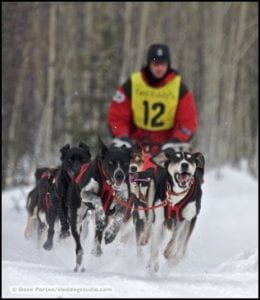 selection for endurance and speed within Alaskan sled dogs and to identify genes effecting athletic performance. Research assisted by Alex Valenti, Joe Thorsrud, Karolynn Ellis, and Sarah Gurnon. The investigation of laryngeal collapse in Alaskan sled dogs is assisted by Tyler Olson. Signals of Selection in Alaskan Sled Dogs
selection for endurance and speed within Alaskan sled dogs and to identify genes effecting athletic performance. Research assisted by Alex Valenti, Joe Thorsrud, Karolynn Ellis, and Sarah Gurnon. The investigation of laryngeal collapse in Alaskan sled dogs is assisted by Tyler Olson. Signals of Selection in Alaskan Sled Dogs - Canine Aging and Longevity – The Vaika Foundation.
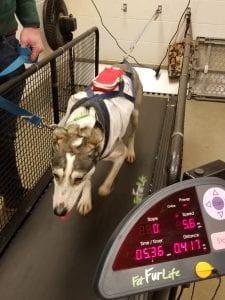 This is a long-term study of aging in a colony of 100 retired Alaskan sled dogs who will live out their natural lifespan at Cornell University. Our dogs enjoy an atypical “laboratory” environment which is anything BUT “laboratory-like”. They have their own kennels for feeding time but enjoy the benefits of housemates throughout the rest of the day and night. They go outside multiple times daily for “playtime” with social groups of dogs in large fenced in fields. Plus, there is no shortage of petting and treats from our extraordinary team of veterinarians, technicians, researchers, and students. The study is supported by the Vaika Foundation whose aim is to improve quality of life and longevity of canines. This research assesses the use of a reverse transcriptase inhibitor on aging with
This is a long-term study of aging in a colony of 100 retired Alaskan sled dogs who will live out their natural lifespan at Cornell University. Our dogs enjoy an atypical “laboratory” environment which is anything BUT “laboratory-like”. They have their own kennels for feeding time but enjoy the benefits of housemates throughout the rest of the day and night. They go outside multiple times daily for “playtime” with social groups of dogs in large fenced in fields. Plus, there is no shortage of petting and treats from our extraordinary team of veterinarians, technicians, researchers, and students. The study is supported by the Vaika Foundation whose aim is to improve quality of life and longevity of canines. This research assesses the use of a reverse transcriptase inhibitor on aging with 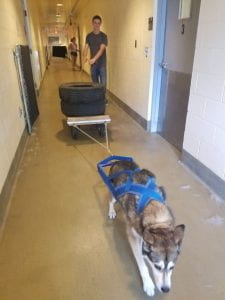 regards to health parameters, behavior, immune function, and physical condition. The project is a collaboration with research partners at Roswell Park Comprehensive Cancer Center led by Dr. Andrei Gudkov and the Vaika Foundation. Dr. John Loftus, veterinarian and immunologist at Cornell’s College of Veterinary Medicine, is Co-PI on this project. I lead the physical conditioning aspects of the project which include over 60 of the dogs being trained weekly and tested biannually on a specially adapted treadmill and assessed for their pulling ability. They are evaluated for their performance and related biological parameters. In addition, I co-supervise the behavior evaluation which is aimed at assessing cognitive decline with aging. I am also responsible for assessing the genetic population structure of our dog colony and manage the undergraduate student researchers assisting with the project. For an overview of the project, read and watch short video and article published by the Cornell Chronicle, “Sled dogs lead the way in a quest to slow aging”. Visit the Vaika Foundation website for a detailed description of the project and individual dogs.
regards to health parameters, behavior, immune function, and physical condition. The project is a collaboration with research partners at Roswell Park Comprehensive Cancer Center led by Dr. Andrei Gudkov and the Vaika Foundation. Dr. John Loftus, veterinarian and immunologist at Cornell’s College of Veterinary Medicine, is Co-PI on this project. I lead the physical conditioning aspects of the project which include over 60 of the dogs being trained weekly and tested biannually on a specially adapted treadmill and assessed for their pulling ability. They are evaluated for their performance and related biological parameters. In addition, I co-supervise the behavior evaluation which is aimed at assessing cognitive decline with aging. I am also responsible for assessing the genetic population structure of our dog colony and manage the undergraduate student researchers assisting with the project. For an overview of the project, read and watch short video and article published by the Cornell Chronicle, “Sled dogs lead the way in a quest to slow aging”. Visit the Vaika Foundation website for a detailed description of the project and individual dogs. - The Genetic Evolution of the Siberian Husky Breed. The investigation of genetic selection within the Siberian Husky breed dependent upon their usage as sled, show, or pet dogs. Research assisted by Karolynn Ellis. Genetic Selection of the Siberian Husky Breed
- Identification of the genetic mechanisms underlying mastitis resistance versus susceptibility in dairy cattle
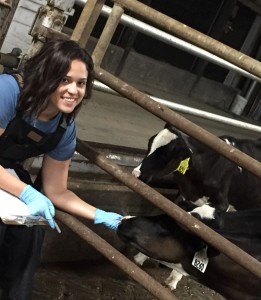
Dr. Asha Miles and their relationship to mammary microbiota. Mastitis is one of the most prevalent diseases in dairy herds world-wide. It is responsible for production loss in terms of reduced milk yield, clinical treatment, culling of animals, and discarded milk. Here, we investigate a cow’s genetic predisposition towards mastitis. Research assisted by Asha Miles and Allison Herrick with many lab members helping in the sampling.
Mastitis Epidemiology in Commercial Dairy Herds of Upstate New York - The effects of selection on crossbred dairy cattle populations. This project aims to compare ancestry in crossbred cattle populations and its relationship to production traits. It will also explore the effects of different crossbreeding schemes on the genome and localize ancestry to known chromosomal regions influencing health and production. Research assisted by Mohd Azwan Jaafar.
- Following genetic progress of the Cornell Vet School Teaching Dairy Herd. This project is supported by Neogen Genomics to provide a unique learning experience utilizing real-time herd genomic evaluations for the Applied Dairy Cattle Genetics course (ANSC 3100).
- Genetic characterization of African goat populations working towards genetic improvement for health, production, and conservation.
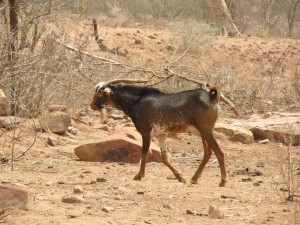 This project lays the foundation for the African Goat Improvement Network (AGIN), a USAID Feed the Future Initiative. A standardized sampling and phenotyping system has been developed and employed across 10 African countries and over 2,500 goats. DNA genotyping of the goats will allow for the identification of distinct African goat populations and the beginning of trait association for improved health and production. The AGIN is a collaborative research group of African based researchers and international scientists. Research assisted by Mary Beth Hannon and John Nystrom.
This project lays the foundation for the African Goat Improvement Network (AGIN), a USAID Feed the Future Initiative. A standardized sampling and phenotyping system has been developed and employed across 10 African countries and over 2,500 goats. DNA genotyping of the goats will allow for the identification of distinct African goat populations and the beginning of trait association for improved health and production. The AGIN is a collaborative research group of African based researchers and international scientists. Research assisted by Mary Beth Hannon and John Nystrom.
African Goat Improvement Network (AGIN): genetic and phenotypic characterization of populations to prioritize conservation and production efforts for small-holder farmers in sub-Saharan Africa - Characterization of Alaskan Musk Ox genetic diversity. The musk ox, Ovibos moschatus, is one of the most ancient mammal species still alive. Similar in appearance to bison, they are actually most closely related to goats and are sp
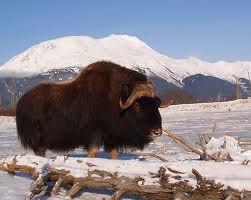 ecialized herbivores of the arctic tundra. This project investigates the genetic diversity of these prehistoric animals for wildlife conservation and the genetic regulation of their unique hair, qiviut. This project is in collaboration with the Musk Ox Farm in Palmer, AK.
ecialized herbivores of the arctic tundra. This project investigates the genetic diversity of these prehistoric animals for wildlife conservation and the genetic regulation of their unique hair, qiviut. This project is in collaboration with the Musk Ox Farm in Palmer, AK.
Completed Projects
- Isle of Jersey Cattle. A comparison of cattle from the Isle of Jersey to US Jersey investigating differences between descendants of the founding Jersey population and modern Jersey.

Dr. Cassandra Stambuk recording digital cushion thickness with an ultrasound A Genetic Investigation of Isle of Jersey Cattle, the Foundation of the Jersey Breed
- The genetic regulation of digital cushion thickness in dairy cows and its association with lameness This project focuses on identifying genetic markers for digital cushion thickness as a tool for reducing lameness. Research assisted by Cassandra Stambuk.
Reducing Dairy Cattle Lameness with Improved Genetic Understanding & Selection for Digital Cushion Thickness - Genetics of Economically Important Traits in U.S. Sheep breeds. A project building the foundation of trait characterization and associated genomic markers for health and production traits in various U.S. sheep breeds. This research has investigated the genetics of out-of-season lambing, hyberbilirubinemia, body size, and coat color in sheep. Research assisted by Chris Posbergh.
- Criollo Cattle Ancestry. Many tropical cattle are composite breeds, crossing naturally adapted indigenous cattle with higher production dairy and beef breeds. Utilizing admixture mapping and ancestry modeling, I would like to identify genomic loci, with corresponding ancestral haplotypes, relating to production, environmental adaptation, disease resistance, and temperament traits. Ancestral
 characterization of genomic regions to economically and culturally important traits would improve the efficacy of selection for propagation and genetic stabilization of desirable traits in cross-bred animals. Research assisted by Ann Staiger.
characterization of genomic regions to economically and culturally important traits would improve the efficacy of selection for propagation and genetic stabilization of desirable traits in cross-bred animals. Research assisted by Ann Staiger.